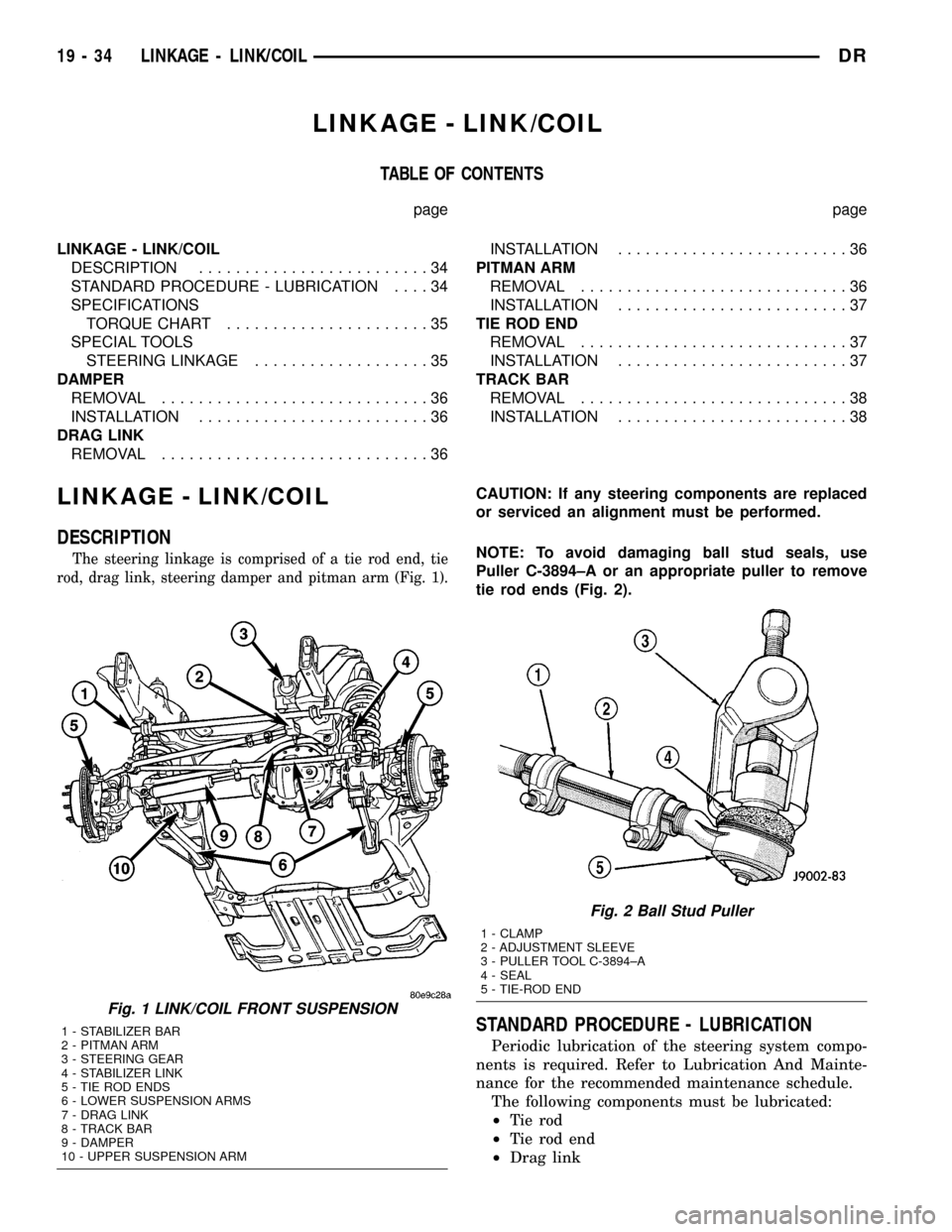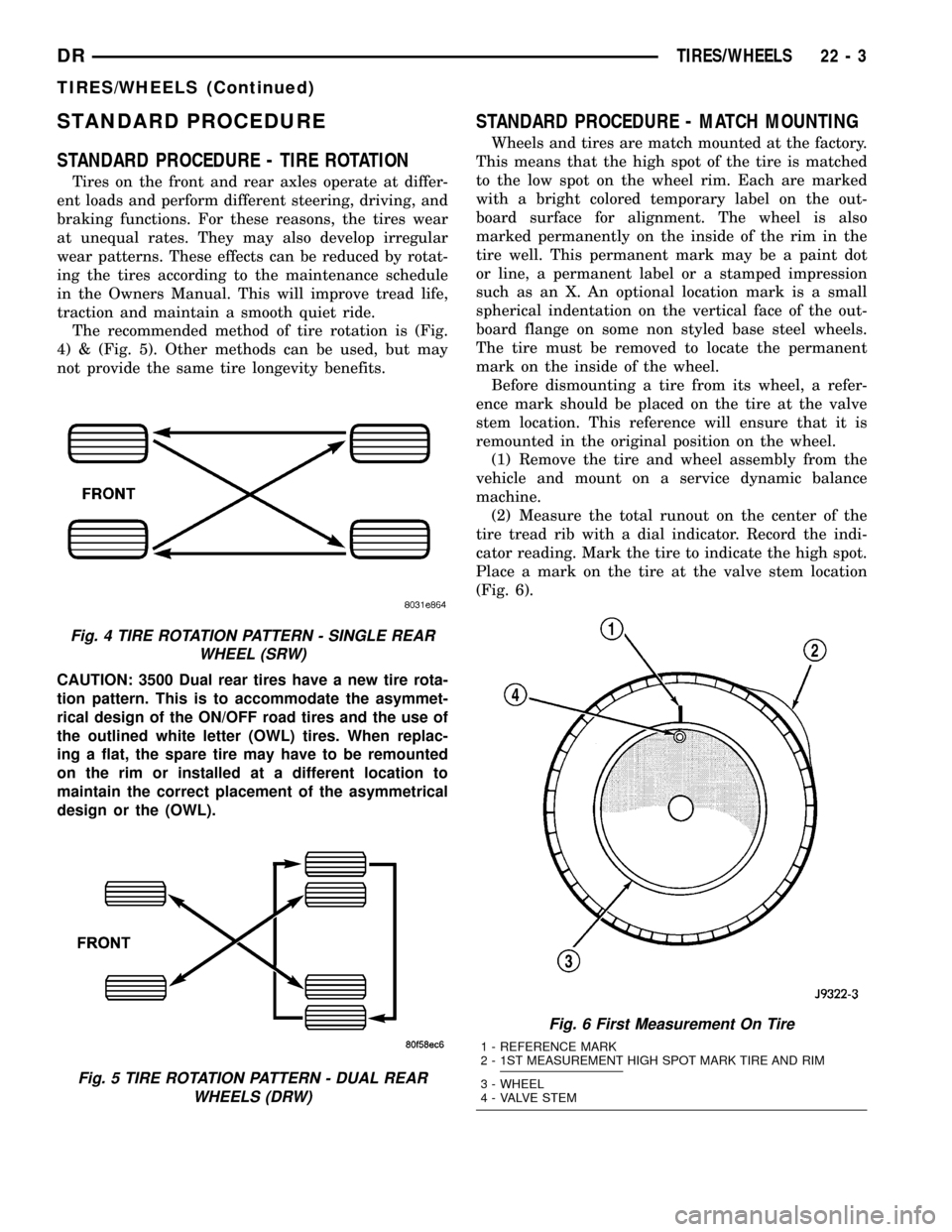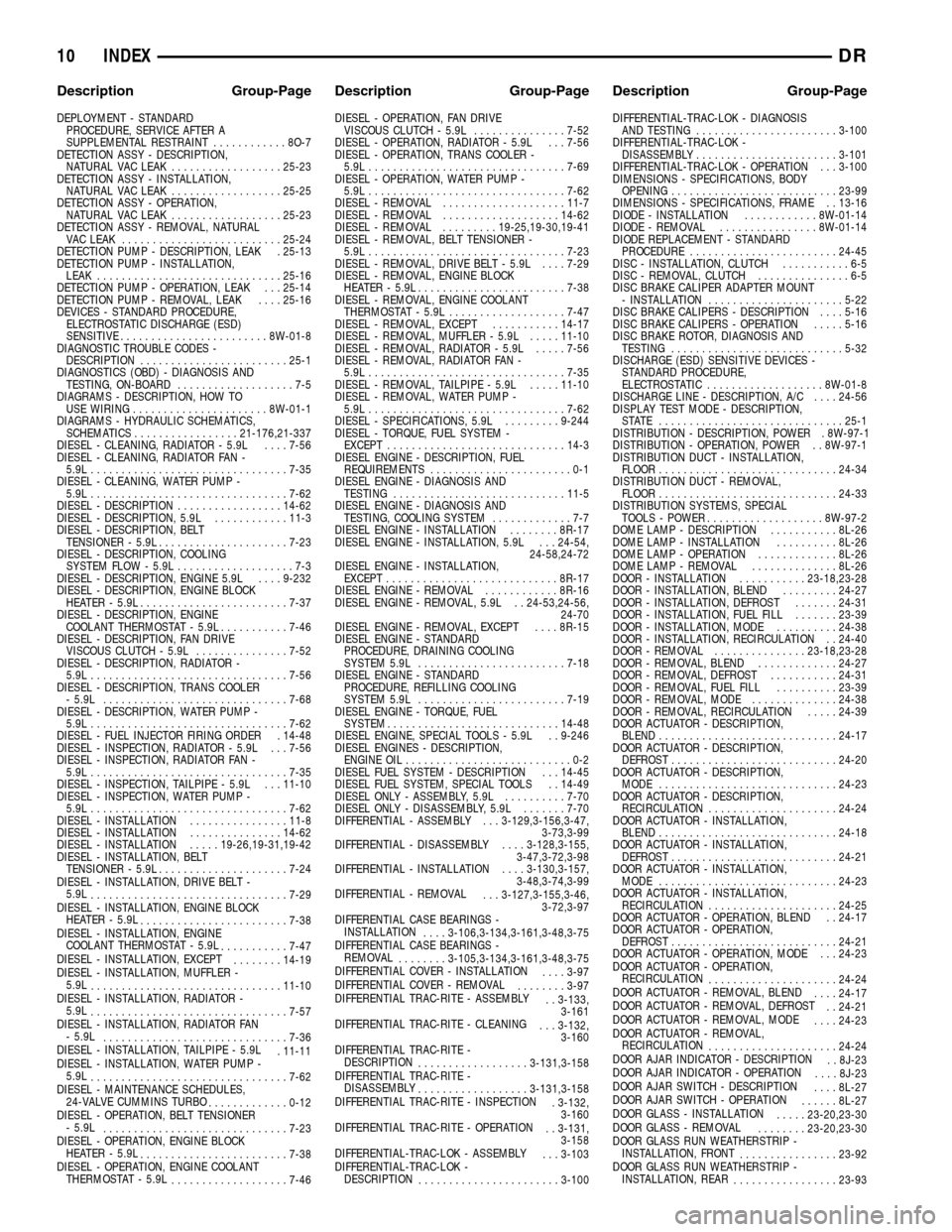1998 DODGE RAM 1500 service schedule
[x] Cancel search: service schedulePage 433 of 2627

For battery system maintenance schedules and
jump starting procedures, see the owner's manual in
the vehicle glove box. Optionally, refer to the Lubri-
cation and Maintenance section of this manual for
the proper battery jump starting procedure. While
battery charging can be considered a maintenance
procedure, the battery charging procedure and
related information are located later in this section of
the service manual. This was done because the bat-
tery must be fully-charged before any battery system
diagnosis or testing procedures can be performed.
OPERATION
The battery system is designed to provide a safe,
efficient, reliable and mobile means of delivering and
storing electrical energy. This electrical energy is
required to operate the engine starting system, as
well as to operate many of the other vehicle acces-
sory systems for limited durations while the engine
and/or the charging system are not operating. The
battery system is also designed to provide a reserve
of electrical energy to supplement the charging sys-
tem for short durations while the engine is running
and the electrical current demands of the vehicle
exceed the output of the charging system. In addition
to delivering, and storing electrical energy for the
vehicle, the battery system serves as a capacitor and
voltage stabilizer for the vehicle electrical system. It
absorbs most abnormal or transient voltages caused
by the switching of any of the electrical components
or circuits in the vehicle.
DIAGNOSIS AND TESTING - BATTERY SYSTEM
The battery, starting, and charging systems in the
vehicle operate with one another and must be tested
as a complete system. In order for the engine to start
and the battery to maintain its charge properly, all of
the components that are used in these systems must
perform within specifications. It is important thatthe battery, starting, and charging systems be thor-
oughly tested and inspected any time a battery needs
to be charged or replaced. The cause of abnormal bat-
tery discharge, overcharging or early battery failure
must be diagnosed and corrected before a battery is
replaced and before a vehicle is returned to service.
The service information for these systems has been
separated within this service manual to make it eas-
ier to locate the specific information you are seeking.
However, when attempting to diagnose any of these
systems, it is important that you keep their interde-
pendency in mind.
The diagnostic procedures used for the battery,
starting, and charging systems include the most
basic conventional diagnostic methods, to the more
sophisticated On-Board Diagnostics (OBD) built into
the Powertrain Control Module (PCM). Use of an
induction-type milliampere ammeter, a volt/ohmme-
ter, a battery charger, a carbon pile rheostat (load
tester), a 12-volt test lamp and/or special service
tools may be required. All OBD-sensed systems are
monitored by the PCM. Each monitored circuit is
assigned a Diagnostic Trouble Code (DTC). The PCM
will store a DTC in electronic memory for any failure
it detects. Always check the PCM for stored trouble
codes before returning the vehicle to service. Refer to
Charging System for the proper charging system test
procedures. Refer to Starting System for the proper
starting system test procedures.
MICRO 420 BATTERY TESTER
The Micro 420 automotive battery tester is
designed to help the dealership technician diagnose a
defective battery. Follow the instruction manual sup-
plied with the tester to properly diagnose a battery.
If the instruction manual is not available, refer to
the standard procedure in this section, which
includes the directions for using the Micro 420 bat-
tery tester.
8F - 2 BATTERY SYSTEMDR
BATTERY SYSTEM (Continued)
Page 436 of 2627

CLEANING
The following information details the recommended
cleaning procedures for the battery and related com-
ponents. In addition to the maintenance schedules
found in this service manual and the owner's man-
ual, it is recommended that these procedures be per-
formed any time the battery or related components
must be removed for vehicle service.
(1) Clean the battery cable terminal clamps of all
corrosion. Remove any corrosion using a wire brush
or a post and terminal cleaning tool, and a sodium
bicarbonate (baking soda) and warm water cleaning
solution (Fig. 1).
(2) Clean the battery tray and battery holddown
hardware of all corrosion. Remove any corrosion
using a wire brush and a sodium bicarbonate (baking
soda) and warm water cleaning solution. Paint any
exposed bare metal.
(3) If the removed battery is to be reinstalled,
clean the outside of the battery case and the top
cover with a sodium bicarbonate (baking soda) and
warm water cleaning solution using a stiff bristle
parts cleaning brush to remove any acid film (Fig. 2).
Rinse the battery with clean water. Ensure that the
cleaning solution does not enter the battery cells
through the vent holes. If the battery is being
replaced, refer to Battery System Specifications for
the factory-installed battery specifications. Confirm
that the replacement battery is the correct size and
has the correct ratings for the vehicle.(4) Clean the battery thermal guard with a sodium
bicarbonate (baking soda) and warm water cleaning
solution using a stiff bristle parts cleaning brush to
remove any acid film.
(5) Clean any corrosion from the battery terminal
posts with a wire brush or a post and terminal
cleaner, and a sodium bicarbonate (baking soda) and
warm water cleaning solution (Fig. 3).
INSPECTION
The following information details the recommended
inspection procedures for the battery and related
components. In addition to the maintenance sched-
ules found in this service manual and the owner's
manual, it is recommended that these procedures be
performed any time the battery or related compo-
nents must be removed for vehicle service.
(1) Inspect the battery cable terminal clamps for
damage. Replace any battery cable that has a dam-
aged or deformed terminal clamp.
(2) Inspect the battery tray and battery holddown
hardware for damage. Replace any damaged parts.
(3) Slide the thermal guard off of the battery case
(if equipped). Inspect the battery case for cracks or
other damage that could result in electrolyte leaks.
Also, check the battery terminal posts for looseness.
Batteries with damaged cases or loose terminal posts
must be replaced.
Fig. 1 Clean Battery Cable Terminal Clamp - Typical
1 - TERMINAL BRUSH
2 - BATTERY CABLE
Fig. 2 Clean Battery - Typical
1 - CLEANING BRUSH
2 - WARM WATER AND BAKING SODA SOLUTION
3 - BATTERY
DRBATTERY SYSTEM 8F - 5
BATTERY SYSTEM (Continued)
Page 1689 of 2627

LINKAGE - LINK/COIL
TABLE OF CONTENTS
page page
LINKAGE - LINK/COIL
DESCRIPTION.........................34
STANDARD PROCEDURE - LUBRICATION....34
SPECIFICATIONS
TORQUE CHART......................35
SPECIAL TOOLS
STEERING LINKAGE...................35
DAMPER
REMOVAL.............................36
INSTALLATION.........................36
DRAG LINK
REMOVAL.............................36INSTALLATION.........................36
PITMAN ARM
REMOVAL.............................36
INSTALLATION.........................37
TIE ROD END
REMOVAL.............................37
INSTALLATION.........................37
TRACK BAR
REMOVAL.............................38
INSTALLATION.........................38
LINKAGE - LINK/COIL
DESCRIPTION
The steering linkage is comprised of a tie rod end, tie
rod, drag link, steering damper and pitman arm (Fig. 1).
CAUTION: If any steering components are replaced
or serviced an alignment must be performed.
NOTE: To avoid damaging ball stud seals, use
Puller C-3894±A or an appropriate puller to remove
tie rod ends (Fig. 2).
STANDARD PROCEDURE - LUBRICATION
Periodic lubrication of the steering system compo-
nents is required. Refer to Lubrication And Mainte-
nance for the recommended maintenance schedule.
The following components must be lubricated:
²Tie rod
²Tie rod end
²Drag link
Fig. 1 LINK/COIL FRONT SUSPENSION
1 - STABILIZER BAR
2 - PITMAN ARM
3 - STEERING GEAR
4 - STABILIZER LINK
5 - TIE ROD ENDS
6 - LOWER SUSPENSION ARMS
7 - DRAG LINK
8 - TRACK BAR
9 - DAMPER
10 - UPPER SUSPENSION ARM
Fig. 2 Ball Stud Puller
1 - CLAMP
2 - ADJUSTMENT SLEEVE
3 - PULLER TOOL C-3894±A
4 - SEAL
5 - TIE-ROD END
19 - 34 LINKAGE - LINK/COILDR
Page 2282 of 2627

STANDARD PROCEDURE
STANDARD PROCEDURE - TIRE ROTATION
Tires on the front and rear axles operate at differ-
ent loads and perform different steering, driving, and
braking functions. For these reasons, the tires wear
at unequal rates. They may also develop irregular
wear patterns. These effects can be reduced by rotat-
ing the tires according to the maintenance schedule
in the Owners Manual. This will improve tread life,
traction and maintain a smooth quiet ride.
The recommended method of tire rotation is (Fig.
4) & (Fig. 5). Other methods can be used, but may
not provide the same tire longevity benefits.
CAUTION: 3500 Dual rear tires have a new tire rota-
tion pattern. This is to accommodate the asymmet-
rical design of the ON/OFF road tires and the use of
the outlined white letter (OWL) tires. When replac-
ing a flat, the spare tire may have to be remounted
on the rim or installed at a different location to
maintain the correct placement of the asymmetrical
design or the (OWL).
STANDARD PROCEDURE - MATCH MOUNTING
Wheels and tires are match mounted at the factory.
This means that the high spot of the tire is matched
to the low spot on the wheel rim. Each are marked
with a bright colored temporary label on the out-
board surface for alignment. The wheel is also
marked permanently on the inside of the rim in the
tire well. This permanent mark may be a paint dot
or line, a permanent label or a stamped impression
such as an X. An optional location mark is a small
spherical indentation on the vertical face of the out-
board flange on some non styled base steel wheels.
The tire must be removed to locate the permanent
mark on the inside of the wheel.
Before dismounting a tire from its wheel, a refer-
ence mark should be placed on the tire at the valve
stem location. This reference will ensure that it is
remounted in the original position on the wheel.
(1) Remove the tire and wheel assembly from the
vehicle and mount on a service dynamic balance
machine.
(2) Measure the total runout on the center of the
tire tread rib with a dial indicator. Record the indi-
cator reading. Mark the tire to indicate the high spot.
Place a mark on the tire at the valve stem location
(Fig. 6).
Fig. 4 TIRE ROTATION PATTERN - SINGLE REAR
WHEEL (SRW)
Fig. 5 TIRE ROTATION PATTERN - DUAL REAR
WHEELS (DRW)
Fig. 6 First Measurement On Tire
1 - REFERENCE MARK
2 - 1ST MEASUREMENT HIGH SPOT MARK TIRE AND RIM
3 - WHEEL
4 - VALVE STEM
DRTIRES/WHEELS 22 - 3
TIRES/WHEELS (Continued)
Page 2597 of 2627

DEPLOYMENT - STANDARD
PROCEDURE, SERVICE AFTER A
SUPPLEMENTAL RESTRAINT............8O-7
DETECTION ASSY - DESCRIPTION,
NATURAL VAC LEAK..................25-23
DETECTION ASSY - INSTALLATION,
NATURAL VAC LEAK..................25-25
DETECTION ASSY - OPERATION,
NATURAL VAC LEAK..................25-23
DETECTION ASSY - REMOVAL, NATURAL
VAC LEAK..........................25-24
DETECTION PUMP - DESCRIPTION, LEAK . 25-13
DETECTION PUMP - INSTALLATION,
LEAK..............................25-16
DETECTION PUMP - OPERATION, LEAK . . . 25-14
DETECTION PUMP - REMOVAL, LEAK....25-16
DEVICES - STANDARD PROCEDURE,
ELECTROSTATIC DISCHARGE (ESD)
SENSITIVE........................8W-01-8
DIAGNOSTIC TROUBLE CODES -
DESCRIPTION........................25-1
DIAGNOSTICS (OBD) - DIAGNOSIS AND
TESTING, ON-BOARD...................7-5
DIAGRAMS - DESCRIPTION, HOW TO
USE WIRING......................8W-01-1
DIAGRAMS - HYDRAULIC SCHEMATICS,
SCHEMATICS.................21-176,21-337
DIESEL - CLEANING, RADIATOR - 5.9L....7-56
DIESEL - CLEANING, RADIATOR FAN -
5.9L................................7-35
DIESEL - CLEANING, WATER PUMP -
5.9L................................7-62
DIESEL - DESCRIPTION.................14-62
DIESEL - DESCRIPTION, 5.9L............11-3
DIESEL - DESCRIPTION, BELT
TENSIONER - 5.9L.....................7-23
DIESEL - DESCRIPTION, COOLING
SYSTEM FLOW - 5.9L...................7-3
DIESEL - DESCRIPTION, ENGINE 5.9L....9-232
DIESEL - DESCRIPTION, ENGINE BLOCK
HEATER - 5.9L........................7-37
DIESEL - DESCRIPTION, ENGINE
COOLANT THERMOSTAT - 5.9L...........7-46
DIESEL - DESCRIPTION, FAN DRIVE
VISCOUS CLUTCH - 5.9L...............7-52
DIESEL - DESCRIPTION, RADIATOR -
5.9L................................7-56
DIESEL - DESCRIPTION, TRANS COOLER
- 5.9L..............................7-68
DIESEL - DESCRIPTION, WATER PUMP -
5.9L................................7-62
DIESEL - FUEL INJECTOR FIRING ORDER . 14-48
DIESEL - INSPECTION, RADIATOR - 5.9L . . . 7-56
DIESEL - INSPECTION, RADIATOR FAN -
5.9L................................7-35
DIESEL - INSPECTION, TAILPIPE - 5.9L . . . 11-10
DIESEL - INSPECTION, WATER PUMP -
5.9L................................7-62
DIESEL - INSTALLATION................11-8
DIESEL - INSTALLATION...............14-62
DIESEL - INSTALLATION.....19-26,19-31,19-42
DIESEL - INSTALLATION, BELT
TENSIONER - 5.9L.....................7-24
DIESEL - INSTALLATION, DRIVE BELT -
5.9L
................................7-29
DIESEL - INSTALLATION, ENGINE BLOCK
HEATER - 5.9L
........................7-38
DIESEL - INSTALLATION, ENGINE
COOLANT THERMOSTAT - 5.9L
...........7-47
DIESEL - INSTALLATION, EXCEPT
........14-19
DIESEL - INSTALLATION, MUFFLER -
5.9L
...............................11-10
DIESEL - INSTALLATION, RADIATOR -
5.9L
................................7-57
DIESEL - INSTALLATION, RADIATOR FAN
- 5.9L
..............................7-36
DIESEL - INSTALLATION, TAILPIPE - 5.9L
. 11-11
DIESEL - INSTALLATION, WATER PUMP -
5.9L
................................7-62
DIESEL - MAINTENANCE SCHEDULES,
24-VALVE CUMMINS TURBO
.............0-12
DIESEL - OPERATION, BELT TENSIONER
- 5.9L
..............................7-23
DIESEL - OPERATION, ENGINE BLOCK
HEATER - 5.9L
........................7-38
DIESEL - OPERATION, ENGINE COOLANT
THERMOSTAT - 5.9L
...................7-46DIESEL - OPERATION, FAN DRIVE
VISCOUS CLUTCH - 5.9L...............7-52
DIESEL - OPERATION, RADIATOR - 5.9L . . . 7-56
DIESEL - OPERATION, TRANS COOLER -
5.9L................................7-69
DIESEL - OPERATION, WATER PUMP -
5.9L................................7-62
DIESEL - REMOVAL....................11-7
DIESEL - REMOVAL...................14-62
DIESEL - REMOVAL.........19-25,19-30,19-41
DIESEL - REMOVAL, BELT TENSIONER -
5.9L................................7-23
DIESEL - REMOVAL, DRIVE BELT - 5.9L....7-29
DIESEL - REMOVAL, ENGINE BLOCK
HEATER - 5.9L........................7-38
DIESEL - REMOVAL, ENGINE COOLANT
THERMOSTAT - 5.9L...................7-47
DIESEL - REMOVAL, EXCEPT...........14-17
DIESEL - REMOVAL, MUFFLER - 5.9L.....11-10
DIESEL - REMOVAL, RADIATOR - 5.9L.....7-56
DIESEL - REMOVAL, RADIATOR FAN -
5.9L................................7-35
DIESEL - REMOVAL, TAILPIPE - 5.9L.....11-10
DIESEL - REMOVAL, WATER PUMP -
5.9L................................7-62
DIESEL - SPECIFICATIONS, 5.9L.........9-244
DIESEL - TORQUE, FUEL SYSTEM -
EXCEPT.............................14-3
DIESEL ENGINE - DESCRIPTION, FUEL
REQUIREMENTS.......................0-1
DIESEL ENGINE - DIAGNOSIS AND
TESTING............................11-5
DIESEL ENGINE - DIAGNOSIS AND
TESTING, COOLING SYSTEM.............7-7
DIESEL ENGINE - INSTALLATION........8R-17
DIESEL ENGINE - INSTALLATION, 5.9L . . . 24-54,
24-58,24-72
DIESEL ENGINE - INSTALLATION,
EXCEPT............................8R-17
DIESEL ENGINE - REMOVAL............8R-16
DIESEL ENGINE - REMOVAL, 5.9L . . 24-53,24-56,
24-70
DIESEL ENGINE - REMOVAL, EXCEPT....8R-15
DIESEL ENGINE - STANDARD
PROCEDURE, DRAINING COOLING
SYSTEM 5.9L........................7-18
DIESEL ENGINE - STANDARD
PROCEDURE, REFILLING COOLING
SYSTEM 5.9L........................7-19
DIESEL ENGINE - TORQUE, FUEL
SYSTEM............................14-48
DIESEL ENGINE, SPECIAL TOOLS - 5.9L . . 9-246
DIESEL ENGINES - DESCRIPTION,
ENGINE OIL...........................0-2
DIESEL FUEL SYSTEM - DESCRIPTION . . . 14-45
DIESEL FUEL SYSTEM, SPECIAL TOOLS . . 14-49
DIESEL ONLY - ASSEMBLY, 5.9L..........7-70
DIESEL ONLY - DISASSEMBLY, 5.9L.......7-70
DIFFERENTIAL - ASSEMBLY . . . 3-129,3-156,3-47,
3-73,3-99
DIFFERENTIAL - DISASSEMBLY....3-128,3-155,
3-47,3-72,3-98
DIFFERENTIAL - INSTALLATION....3-130,3-157,
3-48,3-74,3-99
DIFFERENTIAL - REMOVAL
. . . 3-127,3-155,3-46,
3-72,3-97
DIFFERENTIAL CASE BEARINGS -
INSTALLATION
....3-106,3-134,3-161,3-48,3-75
DIFFERENTIAL CASE BEARINGS -
REMOVAL
........3-105,3-134,3-161,3-48,3-75
DIFFERENTIAL COVER - INSTALLATION
....3-97
DIFFERENTIAL COVER - REMOVAL
........3-97
DIFFERENTIAL TRAC-RITE - ASSEMBLY
. . 3-133,
3-161
DIFFERENTIAL TRAC-RITE - CLEANING
. . . 3-132,
3-160
DIFFERENTIAL TRAC-RITE -
DESCRIPTION
..................3-131,3-158
DIFFERENTIAL TRAC-RITE -
DISASSEMBLY
..................3-131,3-158
DIFFERENTIAL TRAC-RITE - INSPECTION
. 3-132,
3-160
DIFFERENTIAL TRAC-RITE - OPERATION
. . 3-131,
3-158
DIFFERENTIAL-TRAC-LOK - ASSEMBLY
. . . 3-103
DIFFERENTIAL-TRAC-LOK -
DESCRIPTION
.......................3-100DIFFERENTIAL-TRAC-LOK - DIAGNOSIS
AND TESTING.......................3-100
DIFFERENTIAL-TRAC-LOK -
DISASSEMBLY.......................3-101
DIFFERENTIAL-TRAC-LOK - OPERATION . . . 3-100
DIMENSIONS - SPECIFICATIONS, BODY
OPENING...........................23-99
DIMENSIONS - SPECIFICATIONS, FRAME . . 13-16
DIODE - INSTALLATION............8W-01-14
DIODE - REMOVAL................8W-01-14
DIODE REPLACEMENT - STANDARD
PROCEDURE........................24-45
DISC - INSTALLATION, CLUTCH...........6-5
DISC - REMOVAL, CLUTCH...............6-5
DISC BRAKE CALIPER ADAPTER MOUNT
- INSTALLATION......................5-22
DISC BRAKE CALIPERS - DESCRIPTION....5-16
DISC BRAKE CALIPERS - OPERATION.....5-16
DISC BRAKE ROTOR, DIAGNOSIS AND
TESTING............................5-32
DISCHARGE (ESD) SENSITIVE DEVICES -
STANDARD PROCEDURE,
ELECTROSTATIC...................8W-01-8
DISCHARGE LINE - DESCRIPTION, A/C....24-56
DISPLAY TEST MODE - DESCRIPTION,
STATE ..............................25-1
DISTRIBUTION - DESCRIPTION, POWER . 8W-97-1
DISTRIBUTION - OPERATION, POWER . . 8W-97-1
DISTRIBUTION DUCT - INSTALLATION,
FLOOR.............................24-34
DISTRIBUTION DUCT - REMOVAL,
FLOOR.............................24-33
DISTRIBUTION SYSTEMS, SPECIAL
TOOLS - POWER...................8W-97-2
DOME LAMP - DESCRIPTION...........8L-26
DOME LAMP - INSTALLATION..........8L-26
DOME LAMP - OPERATION.............8L-26
DOME LAMP - REMOVAL..............8L-26
DOOR - INSTALLATION...........23-18,23-28
DOOR - INSTALLATION, BLEND.........24-27
DOOR - INSTALLATION, DEFROST.......24-31
DOOR - INSTALLATION, FUEL FILL.......23-39
DOOR - INSTALLATION, MODE..........24-38
DOOR - INSTALLATION, RECIRCULATION . . 24-40
DOOR - REMOVAL...............23-18,23-28
DOOR - REMOVAL, BLEND.............24-27
DOOR - REMOVAL, DEFROST...........24-31
DOOR - REMOVAL, FUEL FILL..........23-39
DOOR - REMOVAL, MODE..............24-38
DOOR - REMOVAL, RECIRCULATION.....24-39
DOOR ACTUATOR - DESCRIPTION,
BLEND.............................24-17
DOOR ACTUATOR - DESCRIPTION,
DEFROST...........................24-20
DOOR ACTUATOR - DESCRIPTION,
MODE.............................24-23
DOOR ACTUATOR - DESCRIPTION,
RECIRCULATION.....................24-24
DOOR ACTUATOR - INSTALLATION,
BLEND.............................24-18
DOOR ACTUATOR - INSTALLATION,
DEFROST...........................24-21
DOOR ACTUATOR - INSTALLATION,
MODE.............................24-23
DOOR ACTUATOR - INSTALLATION,
RECIRCULATION.....................24-25
DOOR ACTUATOR - OPERATION, BLEND . . 24-17
DOOR ACTUATOR - OPERATION,
DEFROST...........................24-21
DOOR ACTUATOR - OPERATION, MODE . . . 24-23
DOOR ACTUATOR - OPERATION,
RECIRCULATION
.....................24-24
DOOR ACTUATOR - REMOVAL, BLEND
....24-17
DOOR ACTUATOR - REMOVAL, DEFROST
. . 24-21
DOOR ACTUATOR - REMOVAL, MODE
....24-23
DOOR ACTUATOR - REMOVAL,
RECIRCULATION
.....................24-24
DOOR AJAR INDICATOR - DESCRIPTION
. . 8J-23
DOOR AJAR INDICATOR - OPERATION
....8J-23
DOOR AJAR SWITCH - DESCRIPTION
....8L-27
DOOR AJAR SWITCH - OPERATION
......8L-27
DOOR GLASS - INSTALLATION
.....23-20,23-30
DOOR GLASS - REMOVAL
........23-20,23-30
DOOR GLASS RUN WEATHERSTRIP -
INSTALLATION, FRONT
................23-92
DOOR GLASS RUN WEATHERSTRIP -
INSTALLATION, REAR
.................23-93
10 INDEXDR
Description Group-Page Description Group-Page Description Group-Page